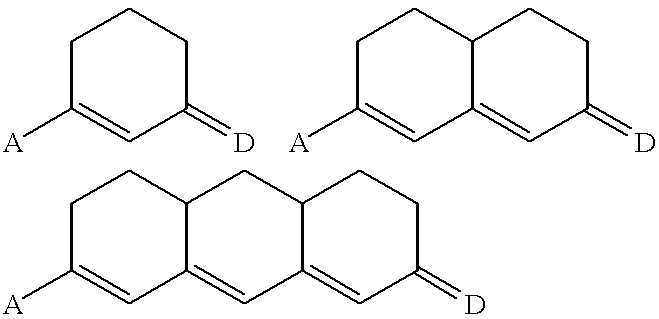Thermally stable molecules with large dipole moments and polarizabilities and applications thereof
a technology of dipole moments and polarizabilities, applied in the field of ringlocked molecules and ring bridges, can solve the problem of linear polarization of molecules, and achieve the effects of reducing the value of the applied field, and high refractive index changes
- Summary
- Abstract
- Description
- Claims
- Application Information
AI Technical Summary
Problems solved by technology
Method used
Image
Examples
example 2 #
#STR19##
To a mixture of carbazole (10.03 g, 60.00 mmol), sodium hydroxide (35 mL, aqueous 50%), benzene (5 mL), and benzyltriethyl ammonium chloride [BTEAC] (0.410 g, 1.8 mmol), 1-bromohexane (12.63 mL, 90 mmol) were added dropwise while stirred. The reaction mixture was stirred at room temperature for 2 h then was poured into water and left overnight. The precipitated solid was collected, washed with water and dried to afford 12.22 g (80%) of 9-hexacarbazole.
To a solution of compound 9-hexacarbazole (12.22 g, 48.61 mmol) in acetic acid (200 mL), nitric acid (5.25 mL, 70%, 58.23 mmol) was added dropwise. After standing one hour at room temperature, the mixture was added slowly to a saturated solution of sodium carbonate (500 mL). The precipitated was collected and purified by flash chromatography using 10:100 (dichloromethane:hexane) to afford 11.52 g (80%) product. .sup.1 H NMR (300 MHz, CDCl.sub.3): .delta. 8.95 (d, J=2.05 Hz, 1 H), 8.35 (dd, J=2.1, 9.3 Hz, 1 H), 8.11 (d, J=7.74 H...
example 3 #
#STR20##
To a solution of the title compound in example 2 (2.20 g, 7.42 mmol) in methanol (50 mL) and hydrochloric acid (36%, 30 mL), tin(II) chloride dihydrate (9.20 g, 40.0 mmol) was added. The mixture was heated to reflux overnight. The methanol was removed under reduced pressure. The solid was collected by filtration then added to a saturated solution of sodium carbonate (50 mL). The mixture was extracted by dichloromethane 3 times. The combined organic layers were dried over magnesium sulfate. Solvent was evaporated under reduced pressure to afford product 1.78 g (91%). .sup.1 H NMR (300 MHz, CDCl.sub.3): .delta. 8.09 (d, J=7.72 Hz, 1 H), 7.58-7.26 (m, 5 H), 6.96 (dd, J=8.53, 2.12 Hz, 1 H), 4.27 (t, J=7.14 Hz, 2 H), 3.65 (s, 3 H), 1.90 (p,J=6.90 Hz, 2 H), 1.39 (br s, 6 H), 0.98 (t, J=6.60 Hz, 3 H). .sup.13 C NMR (75 MHz, CDCl.sub.3): 141.58, 139.69, 126.07, 124.19, 123.03, 121.06, 118.63, 116.24, 109.89, 109.27, 106.89, 43.71, 32.30, 29.68, 27.66, 23.27, 14.78. HRMS cald for C.s...
example 4 #
#STR21##
To a solution of the title compound in example 3 (1.78 g, 6.69 mmol) in THF (25 mL), hexanoyl chloride (1.24 mL, 8.90 mmol) was added. The mixture was stirred overnight. After removing the solvent, the residue was recrystallized in hexane. The product was collected by filtration then dried in vacuo to afford 2.16 g (89%) the title compound. .sup.1 H NMR (300 MHz, CDCl.sub.3): .delta. 8.34 (s, 1 H), 8.02 (d, J=7.59 Hz, 1 H), 7.86 (s, 1 H), 7.54-7.20 (m, 5 H), 4.21 (s, 2 H), 2.42 (t, J=7.60 Hz, 2 H), 1.83-1.79 (m, 4 H), 1.40-1.33 (m, 12 H), 0.97-0.91 (m, 6 H). .sup.13 C NMR (75 MHz, CDCl.sub.3): 172.33, 141.42, 138.18, 130.40, 126.26, 123.36, 123.24, 121.12, 120.18, 119.14, 113.42, 109.25, 109.12, 43.63, 38.71, 32.13, 29.49, 27.50, 26.15, 23.11, 14.59, 14.56.
PUM
| Property | Measurement | Unit |
|---|---|---|
| temperature | aaaaa | aaaaa |
| molecular dipole moments | aaaaa | aaaaa |
| refractive index | aaaaa | aaaaa |
Abstract
Description
Claims
Application Information
 Login to View More
Login to View More - R&D
- Intellectual Property
- Life Sciences
- Materials
- Tech Scout
- Unparalleled Data Quality
- Higher Quality Content
- 60% Fewer Hallucinations
Browse by: Latest US Patents, China's latest patents, Technical Efficacy Thesaurus, Application Domain, Technology Topic, Popular Technical Reports.
© 2025 PatSnap. All rights reserved.Legal|Privacy policy|Modern Slavery Act Transparency Statement|Sitemap|About US| Contact US: help@patsnap.com



